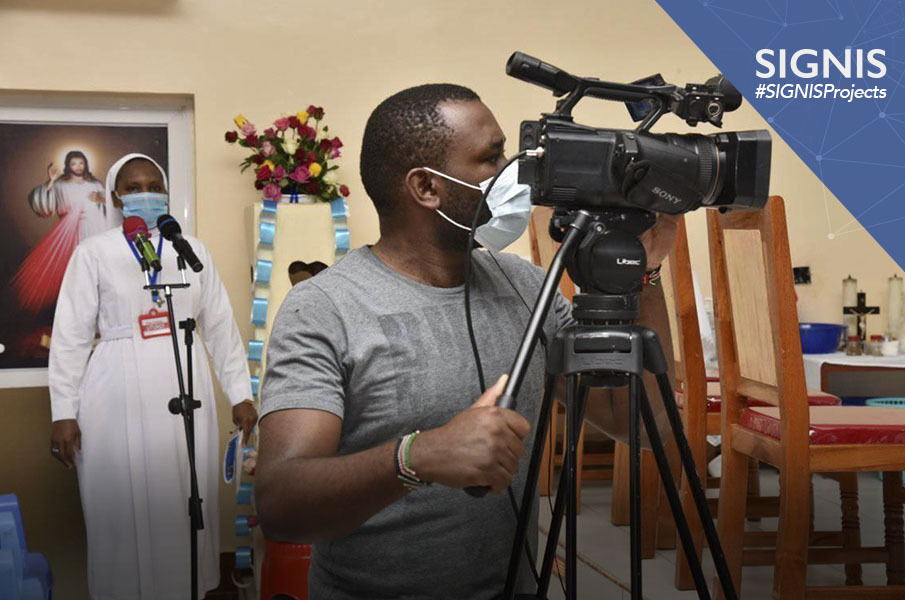Every year, SIGNIS screens project applications on media training, equipment, and production for subsidy from the Pontifical Society of the Propagation of the Faith (PSPF). In 2020, we launched the signisprojectapplication.net online portal, successfully switching from a paper-based to a fully digital application process and making it easier for applicants from all over the world to submit their projects.
In 2018, the Catholic Archdiocese of Mombasa, Kenya, had received subsidies to train parish communication agents on media platforms, including radio. Last year, they applied for subsidies once more, now hoping to receive support for the production of audiovisual programs and further training of communication agents in their work. In this interview, Fr. Raphael Kanga tells us more about the work of their communication office, Lwanga Communication, and how radio and video productions will help educate people on peace-building initiatives, children’s rights, substance abuse and human trafficking, among others.
Could you tell us more about the human impact the project will have on your community?
Fr. Kanga: We plan to produce several educative programs on psychosocial counselling to families, especially during these COVID-19 hard times. We will create programs and videos to empower our people on psychosocial health, deepen the love for their Diocese, and address faith issues. We also plan to expand our diocese readers’ reach via digital print media and improve the Sunday live-streaming of mass thanks to new equipment. Finally, we plan to have more live-streamed programs shared on our Lwanga YouTube channel and improve our Lwanga Communication Facebook page and our archdiocesan website (www.mombasacathoilc.org).
How do you see the situation in your community once the project is implemented?
With the support from SIGNIS and POF, we will reach a great audience and impact them easily on current issues. We anticipate that by making several programs, we will also take care of those who cannot go to church based on their age or health or other possible reasons. Such a category of people will also be able to follow the Sunday mass online. The significant challenges affecting our communities include substance abuse, radicalization, early pregnancies among teenagers, poverty, diseases, and the COVID-19 pandemic. The support on program productions will be helping us to empower our people to face and overcome these life challenges.
What can you tell us about the community where the project is taking place?
The Catholic Archdiocese of Mombasa is situated in the Coastal part of Kenya and serves the four counties of Mombasa, Kwale, Kilifi, and Taita Taveta. The Coastal people include the Taita, Mijikenda, and the urban communities living in town, including the Kambas, the Kikuyus, and the Luos. The strategic plan of the Catholic Archdiocese of Mombasa (2018-2027) estimates the local population in this region to be around 3,000,000 people, of which 675,000 are estimated as the Catholic population. These are the priority audience for the Archdiocese through its various radio, print, and social media platforms. Our Radio Tumaini broadcasts in the Swahili language – the majority language of Mombasa people. However, we do have a few programs in Swahili. Masses are celebrated in Kiswahili in all our 59 Parishes since this is the language understood by many.
What are your main objectives with this project?
We want to provide platforms where the voice of God is communicated by His shepherds and other mandated authorities in the Catholic Archdiocese of Mombasa and reach its diverse audience. We also emphasize training parish collaborators on news sharing and the production of audiovisual and online programs. Finally, we hope to collaborate with other possible networks (local and International) to enrich our content and reach a bigger audience.
What are you the most grateful to SIGNIS for?
With the support of SIGNIS, we were able to train the parish communication agents, who have continued to bring us stories from the parishes as told on our archdiocesan website. We are also grateful that now we have installed a powerful public address system at our Mother of Africa Pastoral Centre Tudor for use by all those who visit the place, whether a small or big group. The radio equipment we received at the initial stages of our radio has enabled us to be where we are today. We can continue to host relevant radio shows and programs for our audience. Also, last year, we live-streamed over 300 masses and were able to do online interviews with the Archdiocesan emergency team and on topics such as parenting and child, sex education, small Christian communities in times of COVID-19 and care of the sick and the elderly during the pandemic.
Why do you think PSPF should continue to support these types of projects?
The POF office, through SIGNIS, supports the mission work of the Church and evangelization, especially in many struggling parts of our world. It’s essential to have the support of communication projects as a way of helping our Archdiocese to continue with the same Mission of Christ who was a Priest, a King, and a Prophet. Our Shepherds today carry the same Mission, and the communication office amplifies their voice to reach our target audience through our different channels. The other important factor to consider is that many Dioceses in Africa and Asia are poor, and our Diocese is not exempted from this category. COVID-19 has also hit us very hard. Left alone, we cannot fulfil this mandate of reaching many Christians who thirst and hunger not just for material food, but for the food of the Soul, the Word of God, a word of hope and consolation, a word of Eternal life. We are so grateful to all the efforts made by our Bishops and the entire Church to support the communication work through POF.


